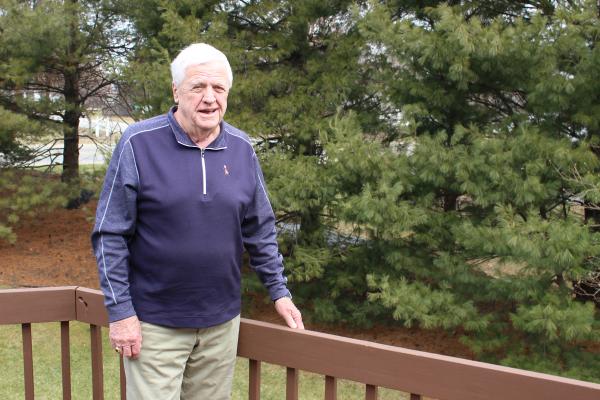
Talk with Jim Waterkotte for a while and you know he is one of a kind.
But not in every way.
Jim had taken a blood thinner for 10 years. So do as many as three million people each year in the United States. Jim took the blood thinner to control life-threatening clotting associated with his heart’s abnormal rhythm, known as atrial fibrillation (Afib).
Blood thinners reduce the risk of blood clot formation associated with Afib that can cause strokes and heart attacks. However, those same life-saving blood thinners can also contribute to life-threatening bleeding in accidental situations.
Aside from a hefty prescription cost, blood thinners didn’t cause Jim any problems until January 2020, when he fell on some black ice and hit his head.
Months later, a blood clot formed on Jim’s brain as a result of the fall. The pressure of the clot contributed to stroke-like symptoms.
“My speech was affected and my whole right side was limp,” he recalled.
Jim underwent brain surgery to remove the clot. Enough of the clot was able to be removed to eliminate the speech and muscle problems the pressure was causing. But not all of the clot was able to be removed due to its sensitive location on the brain. Jim had to stop taking blood thinners to reduce the risk of future brain bleeds.
Living without blood thinners, Jim developed blood clots in his leg later in 2020. They were caught early and no damage was done. But since he could not take blood thinners anymore, he received a filter in his abdomen to stop the leg blood clots from going to his lungs if they moved.
“The fear is there,” Jim said as he thought about the risks of life with and life without blood thinners. “It’s what they call a Catch-22 situation.”
Then, Jim learned he was a candidate for a new heart procedure called WATCHMAN, a minimally invasive procedure performed by John Hammock, MD, invasive cardiologist and electrophysiologist, Blessing Physician Services.
WATCHMAN is an implant that fits into the area of the heart where blood collects and forms clots in people with Afib. WATCHMAN keeps clots from escaping permanently so patients no longer need to take blood thinners.
“It’s a one time, minimally invasive procedure that can permanently reduce the risks of stroke without the worries that come with the lifelong use of blood thinners,” stated Dr. Hammock.
Even though he would be put back on a closely-monitored dose of blood thinner for a short time as part of the WATCHMAN procedure, there was no question about Jim’s decision.
“Let’s plug it up. It takes away the fear,” he said.
“Ninety-six percent of patients are able to stop taking blood thinners 45 days after their WATCHMAN procedure with a reduced risk for stroke,” said Dr. Hammock.
Jim received the WATCHMAN device during a procedure on December 28. He has one more follow-up test to insure the WATCHMAN has appropriately sealed in place before he can live comfortably without taking a daily blood thinner.
“It is exciting to see patient’s faces when we tell them they can transition off their blood thinner, once an adequate seal has formed over the WATCHMAN implant,” added Diana Weatherford, RN, Structural Heart Navigator, Blessing Hospital.
With a positive report at his final post-procedure follow-up appointment, Jim looks forward to a full return to what he calls his activities of daily living.
“I consider myself, for my age, pretty active,” the 81-year-old said. “My hope is that the Watchman allows me to return to the active lifestyle I had before - walking, golfing, and fishing.”
“WATCHMAN can take away the worry,” Dr. Hammock concluded.
